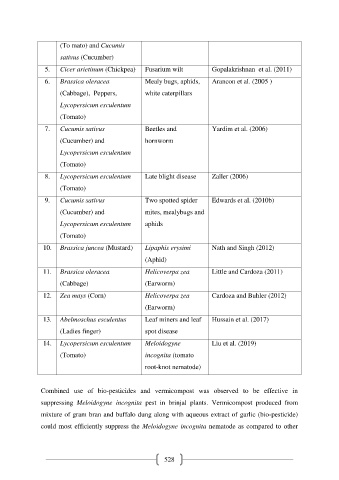Page 538 - e-Book
P. 538
(To mato) and Cucumis
sativus (Cucumber)
5. Cicer arietinum (Chickpea) Fusarium wilt Gopalakrishnan et al. (2011)
6. Brassica oleracea Mealy bugs, aphids, Arancon et al. (2005 )
(Cabbage), Peppers, white caterpillars
Lycopersicum esculentum
(Tomato)
7. Cucumis sativus Beetles and Yardim et al. (2006)
(Cucumber) and hornworm
Lycopersicum esculentum
(Tomato)
8. Lycopersicum esculentum Late blight disease Zaller (2006)
(Tomato)
9. Cucumis sativus Two spotted spider Edwards et al. (2010b)
(Cucumber) and mites, mealybugs and
Lycopersicum esculentum aphids
(Tomato)
10. Brassica juncea (Mustard) Lipaphis erysimi Nath and Singh (2012)
(Aphid)
11. Brassica oleracea Helicoverpa zea Little and Cardoza (2011)
(Cabbage) (Earworm)
12. Zea mays (Corn) Helicoverpa zea Cardoza and Buhler (2012)
(Earworm)
13. Abelmoschus esculentus Leaf miners and leaf Hussain et al. (2017)
(Ladies finger) spot disease
14. Lycopersicum esculentum Meloidogyne Liu et al. (2019)
(Tomato) incognita (tomato
root-knot nematode)
Combined use of bio-pesticides and vermicompost was observed to be effective in
suppressing Meloidogyne incognita pest in brinjal plants. Vermicompost produced from
mixture of gram bran and buffalo dung along with aqueous extract of garlic (bio-pesticide)
could most efficiently suppress the Meloidogyne incognita nematode as compared to other
528

